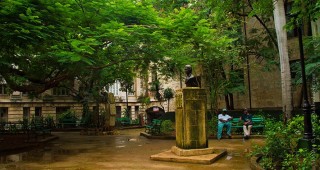Considered one of the seven wonders of Cuban civil engineering, when built, the Focsa building was among the largest reinforced concrete structures in the world. Construction works took 28 months, and their completion in 1956 marked the beginning of the tall-building era in Havana. At a time when concrete buildings with more than 18 floors were simply not practical from a financial viewpoint, this construction, with its 28 floors, was the second tallest concrete building in the world. With beauty parlors, shops, swimming pool and many other facilities, the idea was to create a city within the city, so that tenants would have no need to leave the complex.
All of Focsa’s 373 apartments (among them seven penthouse and two duplex) have great views of the sea and were sold for between 17,500 and 21,500 pesos; and despite that 30 more pesos were charged for every floor up, the apartments on the top floors were sold first. Additionally, being such a tall building for the standards of that time, medical experts were consulted on the effects that the building’s oscillation and vibrations could have had on the tenants.
Providing electricity was quite a challenge too, taking into consideration that all of the apartments were equipped with electric cookers and heaters. Engineers implemented then a distribution system with transformers every three floors, which is still in place with only a few modifications made to it, although the load in much greater today.
In the years following the triumph of the 1959 Revolution, the Focsa building was used to accommodate Russian officials and students. Having reached an appalling state of decay, all of the apartments, the restaurant-bar (formerly the exclusive Club La Torre, for wealthy owners of large companies.) and exterior were renovated and repainted.







 Scenic view/café
Scenic view/café








